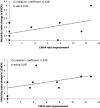Roles of preoperative and early postoperative electrodiagnosis in brachial plexus injury patients undergoing nerve transfer operations: retrospective feasibility study
- PMID: 33866837
- PMCID: PMC8054219
- DOI: 10.1177/03000605211006610
Roles of preoperative and early postoperative electrodiagnosis in brachial plexus injury patients undergoing nerve transfer operations: retrospective feasibility study
Abstract
Objective: The purpose of this retrospective observational study was to assess the feasibility of electrodiagnostic parameters, perioperatively, and to discover optimal values as prognostic factors for patients with brachial plexus injury undergoing nerve transfer operations.
Methods: We retrospectively reviewed the records of 11 patients who underwent nerve transfer surgery. The patients underwent perioperative electrodiagnosis (EDX) before and approximately 6 months after surgery. We evaluated the compound muscle action potential (CMAP) ratio, motor unit recruitment, and their interval changes. To evaluate motor strength, we used the Medical Research Council (MRC) grade, 6 and 12 months after surgery. We evaluated the relationships between improved CMAP ratio, and motor unit recruitment and MRC grade changes 6 and 12 months postoperatively.
Results: All parameters increased significantly after surgery. The CMAP ratio improvement 6 months after surgery correlated with the MRC grade change from baseline to 12 months, with a correlation coefficient of 0.813.
Conclusion: EDX parameters improved significantly postoperatively, and the CMAP ratio improvement 6 months after surgery correlated with the clinical outcomes at 1 year. The results of perioperative EDX might help establish long-term treatment plans for patients who undergo nerve transfer surgery.
Keywords: Brachial plexus; compound muscle action potential; electrodiagnosis; nerve transfer; prognosis; rehabilitation.
Conflict of interest statement
Figures


Similar articles
-
Nerve transfer surgery for adult brachial plexus injury: a 10-year experience at Louisiana State University.Neurosurgery. 2009 Oct;65(4 Suppl):A55-62. doi: 10.1227/01.NEU.0000341165.83218.AC. Neurosurgery. 2009. PMID: 19927079
-
Nerve transfers to the biceps and brachialis branches to improve elbow flexion strength after brachial plexus injuries.J Neurosurg. 2003 Feb;98(2):313-8. doi: 10.3171/jns.2003.98.2.0313. J Neurosurg. 2003. PMID: 12593617
-
The influence of pre-surgical delay on functional outcome after reconstruction of brachial plexus injuries.J Plast Reconstr Aesthet Surg. 2009 Apr;62(4):472-9. doi: 10.1016/j.bjps.2007.11.027. Epub 2008 May 16. J Plast Reconstr Aesthet Surg. 2009. PMID: 18485850
-
Obstetric brachial plexus injuries.Neurosurg Clin N Am. 2009 Jan;20(1):1-14, v. doi: 10.1016/j.nec.2008.07.024. Neurosurg Clin N Am. 2009. PMID: 19064174 Review.
-
The extent of brachial plexus injury: an important factor in spinal accessory nerve to suprascapular nerve transfer outcomes.Br J Neurosurg. 2020 Oct;34(5):591-594. doi: 10.1080/02688697.2019.1639620. Epub 2019 Jul 15. Br J Neurosurg. 2020. PMID: 31307250
References
-
- Aszmann OC, Roche AD, Salminger S, et al.. Bionic reconstruction to restore hand function after brachial plexus injury: a case series of three patients. Lancet 2015; 385: 2183–2189. doi: 10.1016/S0140-6736(14)61776-1 - PubMed
-
- Schreiber JJ, Feinberg JH, Byun DJ, et al.. Preoperative donor nerve electromyography as a predictor of nerve transfer outcomes. J Hand Surg Am 2014; 39: 42–49. doi: 10.1016/j.jhsa.2013.09.042 - PubMed
-
- Croarkin E, Danoff J, Barnes C. Evidence-based rating of upper-extremity motor function tests used for people following a stroke. Phys Ther 2004; 84: 62–74. https://academic.oup.com/ptj/article-abstract/84/1/62/2805335 - PubMed
Publication types
MeSH terms
LinkOut - more resources
Full Text Sources
Other Literature Sources
Medical

